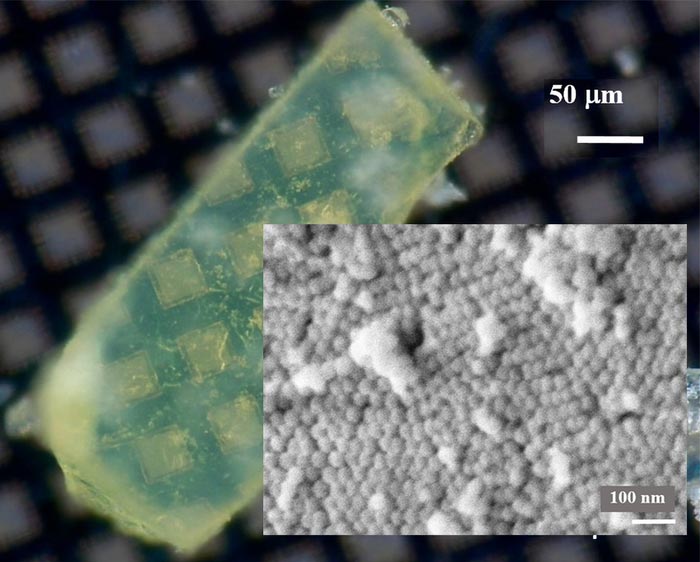Self-assembling and complex, nanoscale mesocrystals can be tuned for a variety of uses

A magnified view reveals nanoscale mesocrystals (inset) starting to assemble and form an ordered supracrystal structure, seen in green.
Credit: Inna Soroka
A research team from KTH Royal Institute of Technology and Max Planck Institute of Colloids and Interfaces reports to have found the key to controlled fabrication of cerium oxide mesocrystals. The research is a step forward in tuning nanomaterials that can serve a wide range of uses —including solar cells, fuel catalysts and even medicine.
Mesocrystals are nanoparticles with identical size, shape and crystallographic orientation, and they can be used as building blocks to create artificial nanostructures with customized optical, magnetic or electronic properties. In nature, these three-dimensional structures are found in coral, sea urchins and calcite desert rose, for example. Artificially-produced cerium oxide (CeO2) mesocrystals—or nanoceria—are well-known as catalysts, with antioxidant properties that could be useful in pharmaceutical development.
“To be able to fabricate CeO2 mesocrystals in a controlled way, one needs to understand the formation mechanism of these materials,” says Inna Soroka, a researcher in applied physical chemistry at KTH. She says the team used radiation chemistry to reveal for the first time the ceria mesocrystal formation mechanism.
Because of their complexity, mesocrystal formation doesn’t follow the same path as ordinary crystals—a process called Ostwald Ripening, where smaller particles in solution dissolve and deposit on larger particles.
The researchers found that a gel-like, amorphous phase forms a matrix in which primary particles, about 3nm in size, align with each other, self-assembling into mesocrystals with a diameter of 30nm.
“If the mesocrystal was a house, this amorphous phase plays the role of the cement that connects the aligned bricks in the walls, Dr. Soroka says.
They also found that the mesocrystals can further self-organize and form supracrystals, visible to the naked eye. “Just as an architect may design not a single house but a whole neighborhood with the houses oriented in a certain way to serve the needs of their inhabitants,” she says.
This multi-level hierarchical architecture of supracrystals is an interesting concept for future materials design, she says. “People are fascinated by the variety of structures and complex forms that are found in nature, such as sea urchins and corals. And scientists are interested in how the crystallation processes work. Our work is a contribution to this understanding.”
Journal: Angewandte Chemie
DOI: 10.1002/anie.202112204
Method of Research: Experimental study
Subject of Research: Not applicable
Article Title: Radiation Chemistry Provides Nanoscopic Insights into the Role of Intermediate Phases in CeO2 Mesocrystal Formation
Article Publication Date: 3-Dec-2021
All latest news from the category: Materials Sciences
Materials management deals with the research, development, manufacturing and processing of raw and industrial materials. Key aspects here are biological and medical issues, which play an increasingly important role in this field.
innovations-report offers in-depth articles related to the development and application of materials and the structure and properties of new materials.
Newest articles

Pinpointing hydrogen isotopes in titanium hydride nanofilms
Although it is the smallest and lightest atom, hydrogen can have a big impact by infiltrating other materials and affecting their properties, such as superconductivity and metal-insulator-transitions. Now, researchers from…

A new way of entangling light and sound
For a wide variety of emerging quantum technologies, such as secure quantum communications and quantum computing, quantum entanglement is a prerequisite. Scientists at the Max-Planck-Institute for the Science of Light…

Telescope for NASA’s Roman Mission complete, delivered to Goddard
NASA’s Nancy Grace Roman Space Telescope is one giant step closer to unlocking the mysteries of the universe. The mission has now received its final major delivery: the Optical Telescope…


